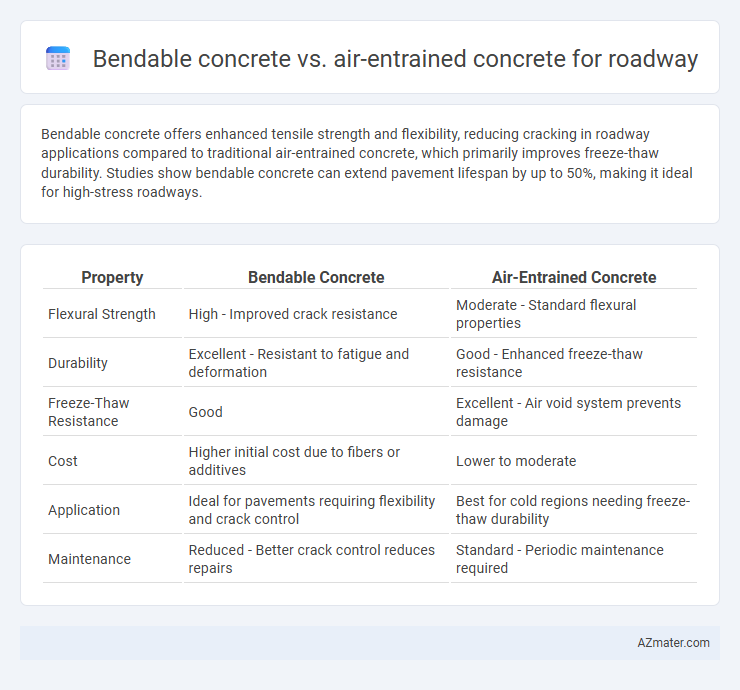Bendable concrete offers enhanced tensile strength and flexibility, reducing cracking in roadway applications compared to traditional air-entrained concrete, which primarily improves freeze-thaw durability. Studies show bendable concrete can extend pavement lifespan by up to 50%, making it ideal for high-stress roadways.
Table of Comparison
| Property | Bendable Concrete | Air-Entrained Concrete |
|---|---|---|
| Flexural Strength | High - Improved crack resistance | Moderate - Standard flexural properties |
| Durability | Excellent - Resistant to fatigue and deformation | Good - Enhanced freeze-thaw resistance |
| Freeze-Thaw Resistance | Good | Excellent - Air void system prevents damage |
| Cost | Higher initial cost due to fibers or additives | Lower to moderate |
| Application | Ideal for pavements requiring flexibility and crack control | Best for cold regions needing freeze-thaw durability |
| Maintenance | Reduced - Better crack control reduces repairs | Standard - Periodic maintenance required |
Introduction to Innovative Concrete Technologies
Bendable concrete, also known as Engineered Cementitious Composite (ECC), offers exceptional tensile strength and flexibility, reducing cracking and enhancing durability for roadway applications. Air-entrained concrete incorporates tiny air bubbles to improve freeze-thaw resistance and workability, making it ideal for climates with fluctuating temperatures. Innovative concrete technologies like these significantly extend pavement lifespan and reduce maintenance costs by addressing common durability challenges in road construction.
Understanding Bendable Concrete: Composition and Properties
Bendable concrete, also known as ductile concrete, incorporates fibers such as polypropylene or glass to enhance tensile strength and flexibility, allowing it to withstand cracking under stress better than traditional concrete. Its composition includes a controlled amount of cement, aggregates, fibers, and admixtures that improve ductility, making it ideal for roadway applications requiring high durability and resistance to thermal and mechanical loading. Compared to air-entrained concrete, which primarily includes entrapped microscopic air bubbles to improve freeze-thaw resistance, bendable concrete offers superior crack control and extended service life in pavement structures.
Air-Entrained Concrete: Key Features and Benefits
Air-entrained concrete contains microscopic air bubbles that enhance freeze-thaw durability and resistance to scaling, making it ideal for roadways exposed to harsh weather conditions. The entrained air improves workability and reduces permeability, minimizing water infiltration and subsequent damage. These features result in longer-lasting pavements with lower maintenance costs compared to conventional concrete types.
Durability Factors: Bendable vs Air-Entrained Concrete
Bendable concrete, characterized by its high tensile strain capacity and fiber reinforcement, shows superior crack resistance and improved durability under heavy traffic loads compared to traditional air-entrained concrete. Air-entrained concrete enhances freeze-thaw durability by incorporating microscopic air bubbles that reduce internal stress from freezing water, making it suitable for cold climates but less effective against flexural stresses. The resilience of bendable concrete to cracking and fatigue extends roadway lifespan, while air-entrained concrete primarily mitigates damage caused by cyclic freezing and thawing cycles.
Flexibility and Crack Resistance Comparison
Bendable concrete exhibits superior flexibility compared to air-entrained concrete, allowing it to absorb stresses and deformations caused by dynamic loads without fracturing. Its high crack resistance stems from engineered fiber reinforcements that control crack width and propagation, enhancing pavement durability under heavy traffic. In contrast, air-entrained concrete primarily improves freeze-thaw resistance but offers limited flexibility and crack control, making bendable concrete a better choice for resilient roadway applications.
Performance Under Freeze-Thaw Cycles
Bendable concrete exhibits superior performance under freeze-thaw cycles due to its enhanced ductility and microcracking resistance, which significantly reduces surface scaling and internal damage. Air-entrained concrete improves freeze-thaw durability by incorporating microscopic air bubbles that alleviate internal pressure from ice formation, but it is more susceptible to strength reduction compared to bendable concrete. Studies indicate that bendable concrete maintains structural integrity longer in harsh freeze-thaw environments, making it a more resilient choice for roadways subject to frequent temperature fluctuations.
Cost Implications for Roadway Construction
Bendable concrete offers enhanced flexibility and crack resistance, potentially reducing long-term maintenance costs despite higher initial material expenses compared to traditional air-entrained concrete. Air-entrained concrete, widely used for freeze-thaw durability in roadway construction, generally involves lower upfront costs but may incur increased repair and replacement expenses due to brittleness over time. Evaluating the total lifecycle cost, including durability and maintenance intervals, is crucial for budget optimization in roadway projects.
Sustainability and Environmental Impact
Bendable concrete, also known as Engineered Cementitious Composite (ECC), offers enhanced durability and crack resistance, reducing maintenance frequency and resource consumption over time, thus promoting sustainability in roadway applications. Air-entrained concrete improves freeze-thaw durability by incorporating microscopic air bubbles, decreasing damage from environmental stressors but may require higher cement content, impacting the carbon footprint. Choosing bendable concrete can lower lifecycle environmental impact through extended service life and reduced repair needs, while air-entrained concrete helps mitigate climate-related deterioration but with a potentially higher initial environmental cost.
Real-World Applications and Case Studies
Bendable concrete, also known as engineered cementitious composite (ECC), demonstrates superior crack resistance and flexibility in roadway applications, reducing maintenance costs in high-traffic areas, as evidenced by its use in highway overlays and bridge decks in Japan and the United States. Air-entrained concrete enhances freeze-thaw durability and reduces scaling, making it ideal for roadways in cold climates, with successful implementations in northern Europe and northern U.S. states where deicing salts are prevalent. Comparative case studies highlight bendable concrete's longer service life and improved fracture control, while air-entrained concrete remains critical for longevity under severe weather exposure.
Conclusion: Optimal Concrete Choice for Modern Roadways
Bendable concrete offers superior flexibility and crack resistance, making it ideal for roadways exposed to heavy traffic loads and temperature variations. Air-entrained concrete enhances durability by improving freeze-thaw resistance, which is critical in colder climates prone to moisture damage. The optimal choice depends on specific environmental conditions and load requirements, with bendable concrete favored for structural resilience and air-entrained concrete for longevity in freeze-prone regions.

Infographic: Bendable concrete vs Air-entrained concrete for Roadway
 azmater.com
azmater.com